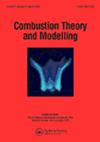定容容器中紊流预混甲烷燃烧局部火焰-壁面相互作用的猝灭模式
IF 1.6
4区 工程技术
Q4 ENERGY & FUELS
引用次数: 0
摘要
研究了局部火焰-壁面相互作用(FWI)的猝灭方式对不同湍流强度的响应,以及对猝灭距离、壁面热流密度和近壁面反应的影响。为此,在初始Karlovitz数(Ka)分别为1.0、10.0和30.0的条件下,对定容容器内的湍流预混甲烷燃烧进行了直接数值模拟。根据湍流燃烧过程中局部燃油消耗速度确定局部火焰壁淬火位置,并根据淬火位置的火焰壁几何关系将局部火焰wi事件划分为4种淬火模式,即正淬(HOQ)、斜壁淬火(斜壁淬火)、侧壁淬火(SWQ)和反向淬火(BOQ)。结果表明,在初始Ka较高的情况下,由于火焰-湍流相互作用,火焰表面呈现出更为复杂的褶皱结构。同时,根据确定的淬火位置确定的局部淬火距离受近壁流的影响较大,局部淬火方式的范围进一步扩展到物料清单。然而,在这三种情况下,居屋和近居屋模式占本地wi的大部分。近壁反应的壁面热流密度和热释放率(HRR)在总质量和总排水量条件下高,在总排水量条件下低。此外,在不同的淬火模式下,一些物质的近壁输运存在差异,这进一步导致了fwi诱导的近壁反应在总HRR和基本HRR上的差异。本文章由计算机程序翻译,如有差异,请以英文原文为准。
Quenching modes of local flame–wall interaction for turbulent premixed methane combustion in a constant volume vessel
The quenching mode of local flame–wall interaction (FWI) is investigated for its response to different levels of turbulence intensity as well as its effect on quenching distance, wall heat flux, and near-wall reaction. For that, direct numerical simulations of turbulent premixed methane combustion in a constant volume vessel are carried with initial Karlovitz numbers (Ka) of 1.0, 10.0, and 30.0. Local flame–wall quenching positions are identified based on the local fuel consumption speed during the turbulent combustion process, and the local FWI events have been classified into four quenching modes according to the flame–wall geometric relationships of quenching positions, namely head-on quenching (HOQ), oblique-wall quenching, side-wall quenching (SWQ), and back-on quenching (BOQ). The results show that in the case with higher initial Ka, the flame surface shows a more complicated wrinkled structure due to the flame–turbulence interaction. Meanwhile, the local quenching distance defined based on the identified quenching position is strongly influenced by the near-wall flow, and the range of the local quenching mode extends further to BOQ. However, for all three cases, HOQ and near-HOQ modes account for the majority of local FWI. Wall heat flux and heat release rate (HRR) of near-wall reaction yield high values for the FWI under HOQ or BOQ and are low for SWQ. In addition, there is a discrepancy in the near-wall transportation of some species under different quenching modes, which further leads to the difference in FWI-induced near-wall reaction regarding its total and elementary HRR.
求助全文
通过发布文献求助,成功后即可免费获取论文全文。
去求助
来源期刊

Combustion Theory and Modelling
工程技术-工程:化工
CiteScore
3.00
自引率
7.70%
发文量
38
审稿时长
6 months
期刊介绍:
Combustion Theory and Modelling is a leading international journal devoted to the application of mathematical modelling, numerical simulation and experimental techniques to the study of combustion. Articles can cover a wide range of topics, such as: premixed laminar flames, laminar diffusion flames, turbulent combustion, fires, chemical kinetics, pollutant formation, microgravity, materials synthesis, chemical vapour deposition, catalysis, droplet and spray combustion, detonation dynamics, thermal explosions, ignition, energetic materials and propellants, burners and engine combustion. A diverse spectrum of mathematical methods may also be used, including large scale numerical simulation, hybrid computational schemes, front tracking, adaptive mesh refinement, optimized parallel computation, asymptotic methods and singular perturbation techniques, bifurcation theory, optimization methods, dynamical systems theory, cellular automata and discrete methods and probabilistic and statistical methods. Experimental studies that employ intrusive or nonintrusive diagnostics and are published in the Journal should be closely related to theoretical issues, by highlighting fundamental theoretical questions or by providing a sound basis for comparison with theory.
 求助内容:
求助内容: 应助结果提醒方式:
应助结果提醒方式:


